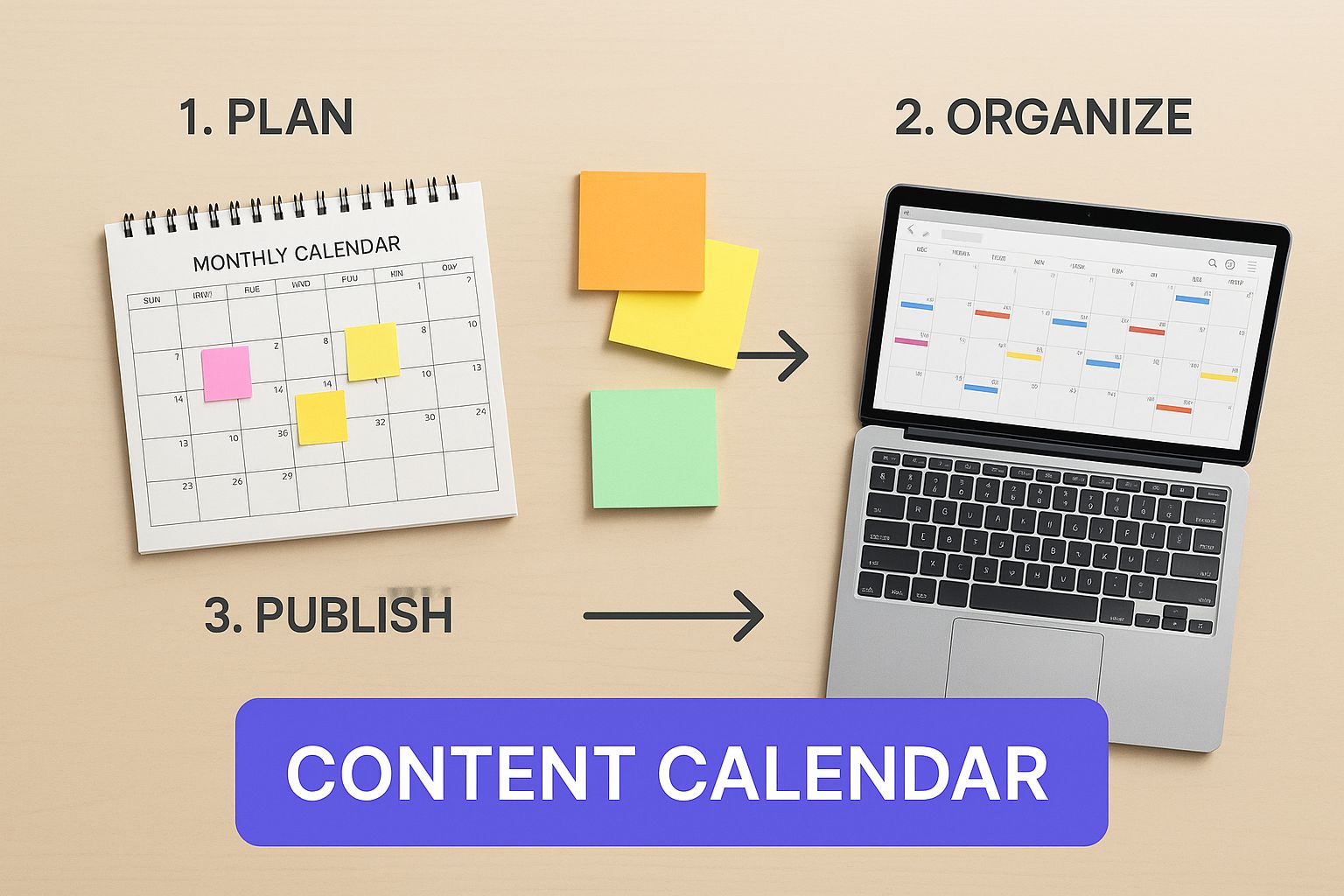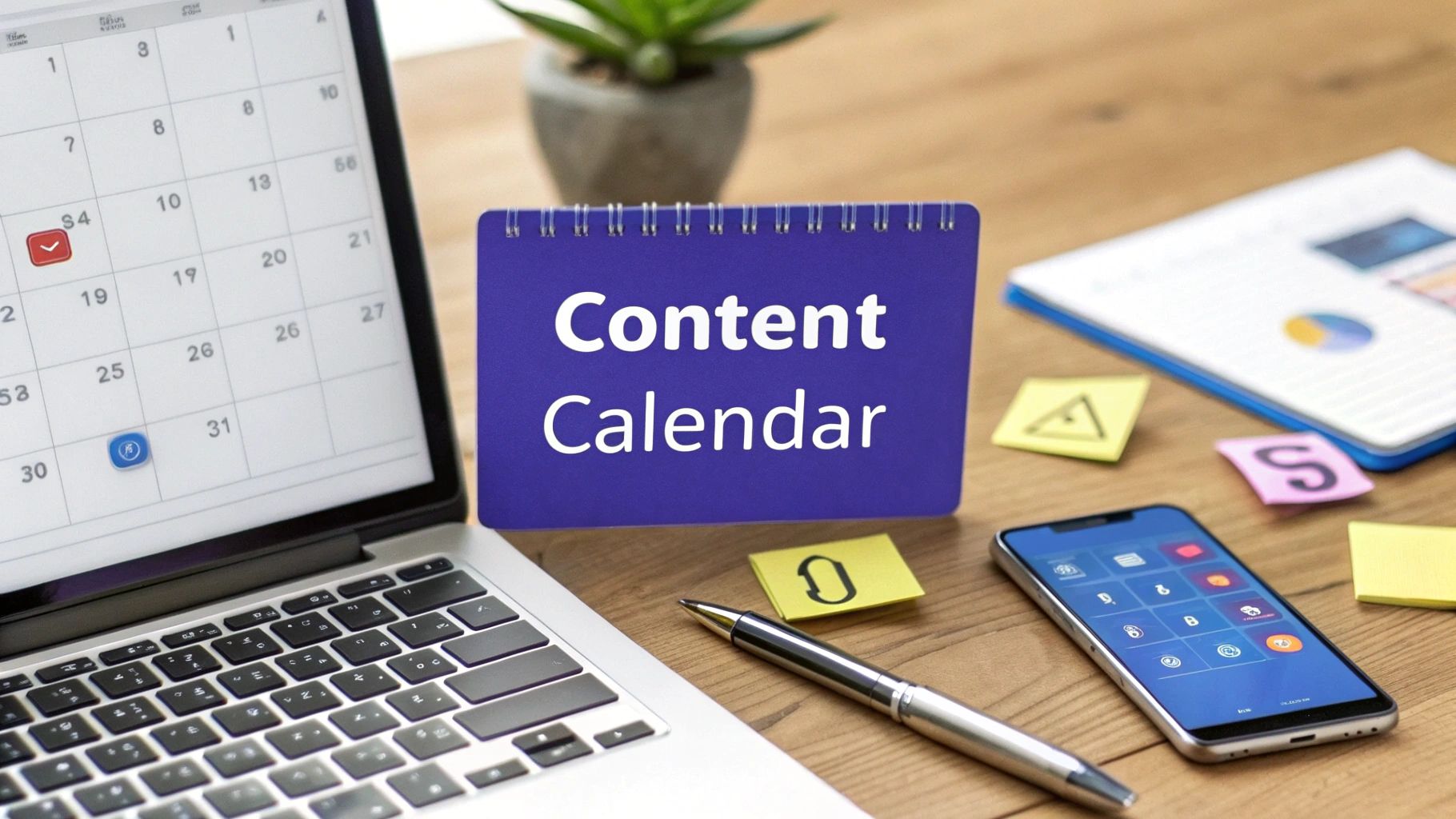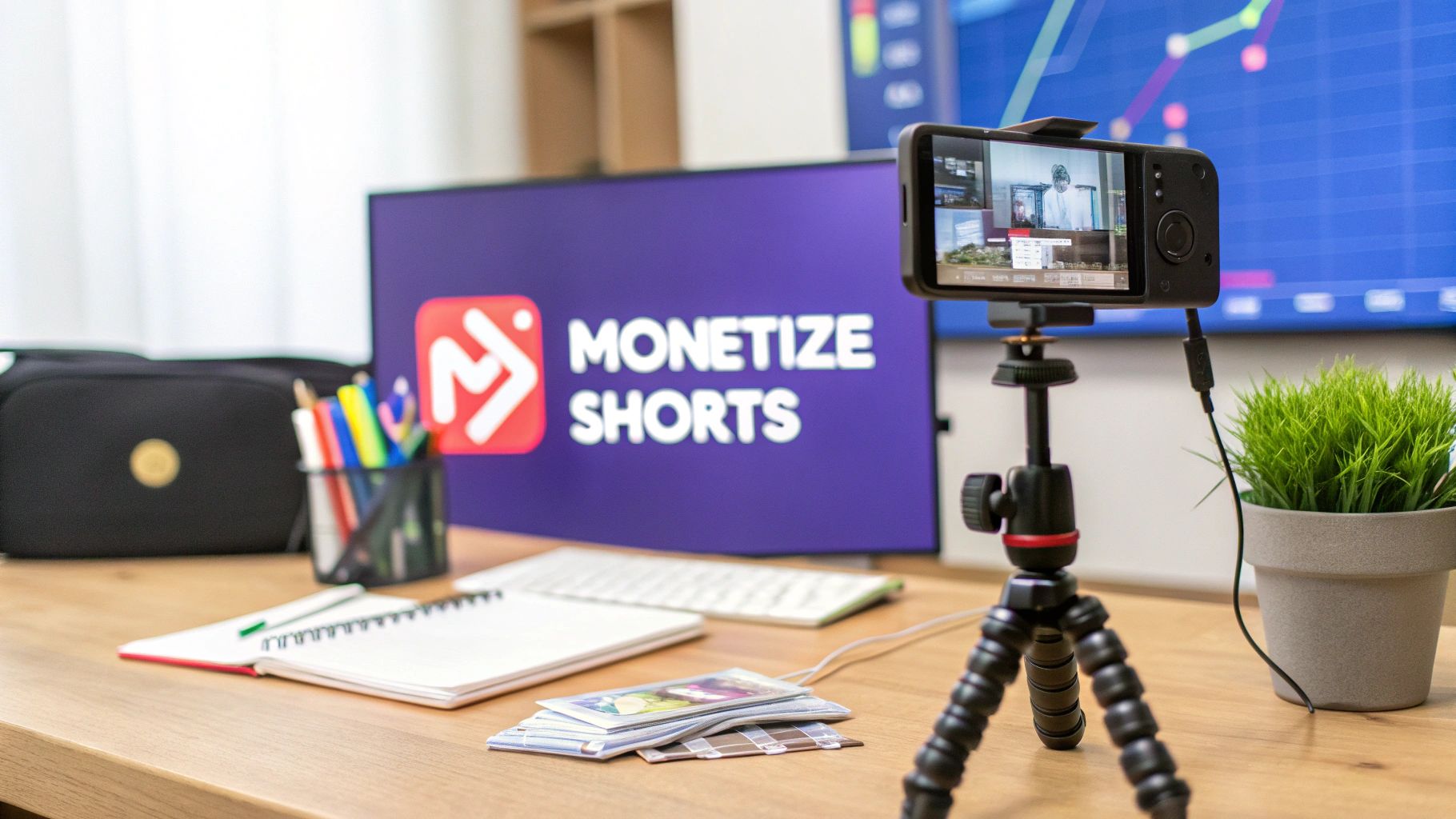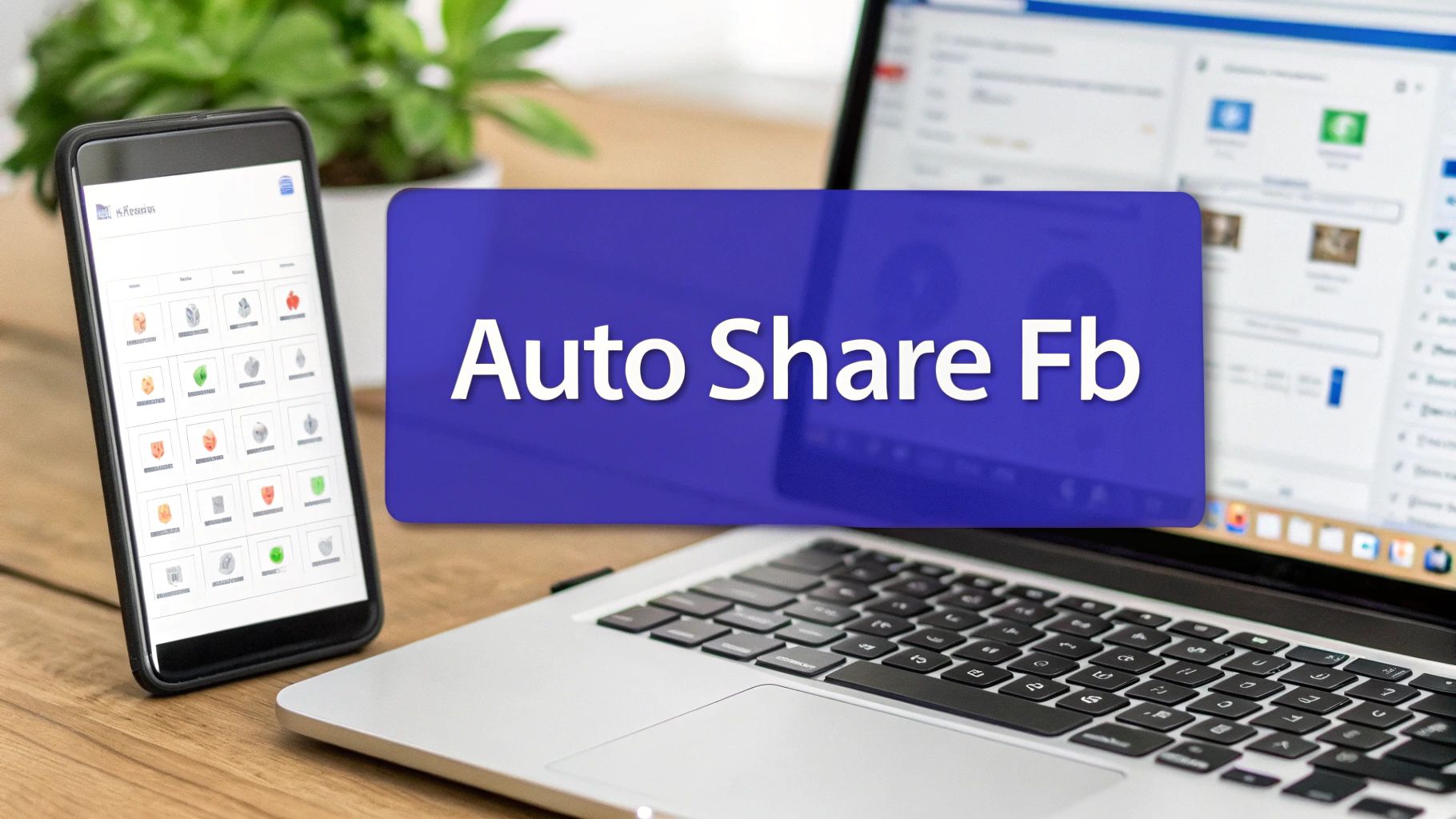When someone says they "plan" their social media content, what does that really mean? Too often, it just means filling a calendar with last-minute ideas to avoid dead air. Let's be real—that’s not a plan. That’s just being reactive.
A true content plan is a deliberate system for deciding what you post, when you post it, and most importantly, why. It’s the shift from frantically thinking, "What should I post today?" to strategically building a narrative that grows your brand.
Beyond Just Filling a Calendar
To do this right, you have to get past the surface level. Real planning is about establishing the 'why' behind every single post. It’s about creating a framework that turns a series of random updates into a cohesive story that actually drives your business forward.
I’ve found this framework really stands on three core pillars: audience intelligence, platform strategy, and performance metrics. If you’re missing any one of these, even the most creative content can completely miss the mark.
Understanding Your Core Components
First thing's first: you have to know who you're talking to. And I mean really know them, not just their age and location. What are their biggest headaches? What kind of content makes them stop scrolling? Which platforms are they actually using every day? This is what we call audience intelligence. Without it, you're just shouting into the void.
Next up is your platform strategy. A killer Instagram Reel idea will probably bomb on LinkedIn. Every platform has its own unwritten rules, user expectations, and algorithm quirks. A solid plan means you're not just cross-posting the same message everywhere. You’re putting the right content—whether it's educational, entertaining, or inspiring—on the right channel.
The goal isn’t to be everywhere, but to be effective where it matters most. A focused strategy on two or three key platforms will always outperform a scattered presence on five or six.
Finally, you need to define what success even looks like with clear performance metrics. Are you trying to build brand awareness? Drive people to your website? Get direct sales? Your goals determine which key performance indicators (KPIs) you should obsess over. This data-driven feedback is what turns a static calendar into a living, breathing growth engine.
For those who want to dive deeper into building out these systems, there are some really comprehensive resources on social media content strategy that can take you from the basics to more advanced techniques.
To build a social media plan that actually works, you need to have a few essential components in place. This table breaks down the core elements that form the foundation of a modern, effective strategy. Think of it as your blueprint.
Core Components of a Modern Content Plan
| Component | Objective | Key Action |
|---|---|---|
| Audience Intelligence | Know who you're talking to on a deep level. | Build detailed audience personas using your analytics data. |
| Platform Strategy | Match your content style to the right channel. | Pick the platforms where your specific audience is most engaged. |
| Performance Metrics | Define what a "win" looks like for your brand. | Track KPIs that directly connect to your core business goals. |
Once you've got these pieces figured out, you're no longer just posting content—you're strategically planning it. This is how you make sure every tweet, story, and video has a clear purpose, pushing you closer to your goals and building a much stronger, more connected community around your brand.
Defining Your Audience and Setting Clear Goals

Before you even dream up your next viral post, we need to get back to basics. It all boils down to two simple questions: who are you talking to, and what do you want them to do? A brilliant content idea is just noise if it doesn't reach the right people or connect back to a real business objective.
Posting without a clear audience is like shouting into a crowded room and hoping for the best. We need to move past generic assumptions and build a profile so detailed it feels like you're talking to a real person, not just a set of demographics.
Mining for Real Audience Insights
Forget guesswork. The best insights are probably hiding in places you already have access to. The trick is to combine data from a few key sources to paint a complete picture of your ideal customer.
Here’s where I always start:
- Social Media Analytics: Your platform's built-in tools, like Instagram Insights or Facebook Business Suite, are a goldmine. Dig into the age, gender, location, and, most importantly, the most active times of your current followers.
- Website Traffic Data: Pop open Google Analytics and see who is coming to your site from your social channels. Which pages do they land on? How long do they stick around? This tells you what content genuinely grabs their attention.
- Customer Support Tickets: Your support team is on the front lines, talking to your customers every single day. Ask them about the most common questions, frustrations, and feedback they hear. This is unfiltered, direct insight into what your audience actually needs.
Let’s say a B2B SaaS company discovers through support tickets that users are constantly confused by a specific feature. Boom. That's a perfect opportunity to create a series of quick, helpful video tutorials for LinkedIn, directly solving a known customer pain point.
Setting Goals That Actually Mean Something
Once you know exactly who you're talking to, you have to define what a "win" looks like. Vague goals like "increase engagement" just don't cut it. Your objectives have to be tangible and tie directly to your business's bottom line.
This is where the SMART framework is your best friend.
Your goals must be Specific, Measurable, Achievable, Relevant, and Time-bound. So, instead of a flimsy goal like "get more followers," you create a solid one: "Increase our Instagram follower count by 15% in the next quarter by running a targeted ad campaign and a weekly giveaway."
See the difference? This level of clarity turns your content planning from a fun creative exercise into a strategic business driver. A D2C fashion brand might set a goal to "drive $10,000 in sales from TikTok Shop in Q3," which immediately focuses their content strategy on creating engaging, shoppable videos that feature their latest collection.
This strategic foundation also helps you decide which trends to jump on. For 2025, things like influencer partnerships and AI are becoming core to content planning. Smart marketers are paying close attention to shifting consumer habits, with about 59% planning to ramp up their influencer collaborations. And it's easy to see why—a whopping 76% of social media users say social content has swayed their purchasing decisions. That number rockets to 90% for Gen Z, who now often use platforms like TikTok as their main search engine. You can find more of these insights in the latest digital marketing statistics on Marketing Dive.
Building Your System for Content Ideation
We’ve all been there. That sinking feeling of staring at a blank content calendar, with the empty squares silently mocking you. The pressure to come up with something brilliant is a major source of stress for anyone managing social media.
But here’s the secret: the solution isn’t about chasing one viral idea. It’s about building a repeatable, reliable system that keeps good ideas flowing. This system is what separates the frantic, last-minute posters from the strategic, confident brands.
First, you have to ditch the "one-off" post mentality. Great social media isn't built on isolated flashes of genius. It's built on a solid foundation of themes, what we call content pillars. Think of these as the three to five core topics your brand has genuine authority to discuss.
For a company selling fitness apparel, for instance, those pillars might look something like this:
- Workout Motivation & Tips
- Product Performance & Fabric Tech
- Healthy, Simple Recipes
- Athlete & Community Spotlights
By defining these pillars, you’re not limiting your creativity—you're focusing it. Every single idea you generate should fit neatly into one of these buckets. This simple framework keeps your feed consistent and lets your audience know exactly what kind of value to expect from you.
Turn Existing Assets into a Content Goldmine
One of the smartest ways to fill your calendar is to stop assuming every post has to be built from scratch. Your best content might already be sitting on your hard drive. This is where repurposing becomes your superpower.
Look at your long-form content. That hour-long webinar you hosted last quarter? It's a treasure trove. You can slice it into a dozen short video clips, pull out key quotes for graphics, and create a carousel post summarizing the main takeaways. What about that in-depth case study? It's the perfect source for multiple posts highlighting powerful stats, customer testimonials, and problem-solving tips.
This approach doesn't just save a massive amount of time; it reinforces your core marketing messages over and over again.
In today's media environment, this kind of versatility is non-negotiable. With around 5.42 billion people on social media globally, the average person is active on nearly seven different networks each month. That fragmentation means a one-size-fits-all content plan just won't work. Your strategy has to be diverse, especially when you consider that 78% of people prefer learning about new products through short-form video. You can dig deeper into this and other crucial social media statistics on Sprout Social.
Develop a Balanced Content Mix
Not every post should be a sales pitch. In fact, most shouldn't be. To keep your audience genuinely engaged and coming back for more, you need a balanced mix of content that serves different needs. I find it helpful to think about it in three simple categories:
- Educate: Teach your audience something valuable. This could be a "how-to" guide, a quick tip that solves a common frustration, or an explanation of industry jargon. You're the expert—share that knowledge.
- Entertain: Give your audience a reason to smile, laugh, or feel inspired. This is where you can let your brand's personality shine with memes, behind-the-scenes content, or by jumping on a fun trend.
- Convert: Gently guide your audience toward taking action. This is where you post about new products, exclusive offers, webinar sign-ups, or powerful customer testimonials.
A healthy content mix often follows the 80/20 rule: 80% of your content should provide value by educating or entertaining, while only 20% should be directly promotional. This is how you build trust and prevent your audience from tuning you out.
To really put this all into practice, you need a central hub to organize your pillars, ideas, and post details. An ideation system is only as good as its execution. To learn how to make this system work for you, check out our guide on how to create a social media calendar. This is the final step that turns your brainstorming into a smooth, actionable workflow, helping you batch content and maintain a powerful brand identity with way less stress.
Managing Your Content Calendar and Workflow
An idea is just an idea until you give it a deadline. Without a solid system to organize, schedule, and publish your content, even the most brilliant concepts will collect digital dust. This is where a well-managed content calendar and a smooth workflow make all the difference, turning your social media planning from a chaotic scramble into a strategic, repeatable process.
The tool you pick is far less important than your commitment to actually using it. You don't need a fancy, expensive platform to get organized. Honestly, many of the most successful teams I've worked with started with a simple, purpose-built spreadsheet. It gives you total control and you can customize it to fit your exact needs. If you're starting from scratch, grabbing a comprehensive social media calendar template is a great way to hit the ground running.
As your team or content output grows, you'll likely graduate to something more robust like Asana, Trello, or a dedicated social media management platform like Buffer or Sprout Social. But the core principles remain the same.
Building Your Calendar Structure
Your calendar needs to be the single source of truth for everything social media. To cut down on the last-minute DMs and frantic questions, every single entry should have a few non-negotiable details. This keeps everyone on the same page and moving in the right direction.
Make sure every planned post includes these essentials:
- Final Post Copy: The exact, approved text that will be published. No guesswork.
- Visuals: A direct link to the final, approved image, graphic, or video file.
- Target Platform(s): Clearly state where the post is going (e.g., Instagram Feed, LinkedIn, TikTok).
- Publish Date & Time: The specific moment the post is scheduled to go live.
- Review Status: A simple tag everyone understands, like "Draft," "In Review," or "Approved."
This level of detail might seem tedious at first, but it completely eliminates ambiguity. It ensures that what gets published has been properly vetted and aligns perfectly with your strategy.
Some of the best content plans I’ve seen use a mix of digital tools and physical boards, just like the one below. It’s a fantastic way to visualize the entire month at a glance.

This visual approach is especially helpful for making sure you have a balanced mix of content—not too promotional, with plenty of educational and entertaining posts mixed in.
From Calendar to Community Engagement
With your calendar structured, the next piece of the puzzle is establishing a consistent posting rhythm. This isn't about spamming your followers; it’s about being reliable. Consistency builds anticipation and teaches your audience when to look for fresh content from you. Start with a cadence you know you can maintain, then use your analytics to fine-tune it over time.
Pro-Tip: The real magic of a calendar isn't just organization; it's automation. By using scheduling tools, you can batch-create and schedule weeks of content in one sitting. This frees you from the daily grind of manual posting and gives you back precious hours to focus on what truly matters—engaging with your community in real-time.
A streamlined approval process is also crucial for preventing bottlenecks. For most teams, a simple two-step flow works best: the content creator finalizes a post and marks it as "In Review," and a designated approver gives the final "Approved" status. If you want to take this a step further, exploring various workflow automation examples can give you some powerful ideas for making the entire process even more efficient.
How to Measure Performance and Refine Your Plan

Here’s a hard truth: a content plan is only as good as the results it delivers. I’ve seen too many marketers pour their hearts into creating content, only to have no idea if it’s actually working.
Effective social media planning isn't a "set it and forget it" task. It’s a living, breathing process—a continuous loop of creating, measuring, and refining. This is where you turn raw data into smart decisions, making sure your efforts aren’t just busywork but a direct line to your business goals.
The biggest mistake you can make is getting caught up in vanity metrics. A post with a ton of likes feels great, but it doesn’t pay the bills. Instead, your focus needs to be on the Key Performance Indicators (KPIs) that connect directly to the SMART goals you set earlier. This is how you prove your plan's value.
Focus on Metrics That Matter
To get a real feel for your performance, you have to track data that shows genuine audience connection and business impact. It’s about shifting from surface-level numbers to meaningful indicators that tell you a story.
These are the core metrics I always keep a close eye on:
- Engagement Rate: This is so much more than likes. I'm talking about comments, shares, and saves—actions that signal your audience finds your content valuable enough to interact with or come back to. It's the truest pulse check on your community's health.
- Click-Through Rate (CTR): If your goal is to drive traffic from social to your website, this metric is non-negotiable. It tells you exactly how compelling your call-to-action is. Is your copy actually making people move?
- Conversions: This is the bottom line. Whether a conversion for you is a sale, a lead form submission, or a newsletter signup, tracking this shows the direct financial return on your social media work.
- Share of Voice (SOV): This one is powerful. It measures how much of the conversation around your industry belongs to your brand versus your competitors. It's a fantastic indicator of brand awareness and authority.
An effective content plan is agile. Don't be afraid to pivot your strategy based on what the data tells you. A "failed" post is just a learning opportunity that informs your next move.
If you really want to get this right, it's worth taking a deeper look into how to measure social media engagement with a more focused guide.
The Power of Listening and Refining
So, how do you gather all this data? It’s a mix of using the native analytics on each platform and, for deeper insights, bringing in third-party dashboards. Tools like the one pictured above are incredible for monitoring conversations and sentiment across the web, giving you a serious competitive edge.
With users spending an unbelievable 14 billion hours on social media every single day, you simply can't afford to ignore what's being said. In fact, using listening tools can literally double your confidence in ROI, boosting it from 27% to 67% on a platform like Facebook.
The final piece of the puzzle is setting up a regular review cycle. I’ve found that a comprehensive content review every quarter works best. During this review, you'll want to pinpoint your top-performing themes, posts, and formats.
Ask yourself:
- What content actually drove the most conversions?
- Which posts earned the highest engagement rate?
- What topics got people talking the most?
Use these insights to double down on what works and cut what doesn't. This data-driven feedback loop is what transforms a good content plan into a great one, ensuring your strategy evolves and consistently delivers a higher return on your effort.
For a complete overview of this process, you can also explore our detailed article on how to measure social media success.
Frequently Asked Questions About Content Planning
As you start laying out your social media content, the questions are bound to bubble up. Getting a handle on strategy, post frequency, and fresh ideas can feel like a lot, but a few clear answers can make all the difference between feeling overwhelmed and feeling in control.
I'm going to walk you through some of the most common questions I hear from marketers and creators. The goal here is direct, real-world advice to help you fine-tune your approach and build a content plan you can actually stick with.
How Far in Advance Should I Plan Content?
This is all about finding the sweet spot between being prepared and staying flexible. If you plan too far out, your content can feel stale and out of touch with what's happening right now. But if you don't plan far enough, you're constantly scrambling to post something—anything—at the last minute.
For most brands, planning one full month in advance is the magic number. It gives your team enough time to create high-quality content, run it through approvals, and schedule everything without the last-minute panic. It’s also a great timeframe for building a little momentum around a theme or campaign.
But, of course, this isn't a one-size-fits-all rule.
- Major Campaigns: If you're gearing up for something big like a product launch, a major holiday sale, or a brand partnership, you'll want to extend that window to a full quarter (three months). This gives you the runway for more complex coordination across all your marketing channels.
- Highly Reactive Platforms: For a fast-moving platform like X (formerly Twitter), your core content might be planned a month out, but you should absolutely leave daily slots open for jumping on trends and joining real-time conversations.
Your content calendar should be a guide, not a prison. The key is having a solid plan for structure while building in the flexibility to react to the unexpected.
Getting this balance right is a core part of learning how to plan social media content that genuinely connects with people.
What Is the Ideal Posting Frequency?
Ah, the million-dollar question. And the honest-to-goodness answer is: there's no single magic number. Your "ideal" posting frequency comes down to the specific platform, your audience's habits, and—most importantly—what your team can realistically create without sacrificing quality.
Consistency will always, always beat raw quantity. It's so much better to share three amazing posts a week that your audience loves than to churn out two mediocre posts a day that get completely ignored.
Here’s a general guide you can use as a starting point. From here, test, measure, and adjust.
- Instagram: Aim for 3-5 feed posts per week. You'll want to supplement that with daily Stories (think 5-10 frames) and 2-3 Reels a week to really maximize your reach.
- Facebook: A solid baseline is 3-5 posts per week. The algorithm favors real engagement, so your focus should be on creating posts that actually start a conversation.
- LinkedIn: For most brands, 2-4 high-quality posts per week is incredibly effective. The vibe here is all about professional insights, industry value, and company culture.
- TikTok: This platform lives on volume and trends. If TikTok is a priority for you, you should be aiming for at least one video per day.
- X (Twitter): Because it's so fast-paced, you can easily post 3-5 times per day (or even more), especially if you're actively engaging in live conversations.
Start with a schedule you know you can stick to. Then, get into your analytics. Find out when your audience is actually online and engaging, and let that data guide your posting cadence, not some generic industry benchmark.
How Do I Consistently Come Up With Fresh Ideas?
Staring at a blank content calendar is one of the most intimidating feelings in marketing. But the secret to an endless well of ideas isn't some stroke of creative genius—it's having a reliable system. A systematic approach means you'll always have a backlog of great topics ready to go.
First things first, ground your strategy in content pillars. These are the 3-5 core topics your brand can speak on with authority. Every single idea you generate should tie back to one of these pillars. This keeps your content focused and your message consistent.
Next, build these habits into your regular workflow:
- Monitor Your Competitors: Keep a close eye on what your top 3-5 competitors are doing. Don't copy them. Instead, analyze what's working for them and why. What topics are getting traction with their audience (which is probably a lot like yours)? Look for the gaps they're missing—that's your opportunity.
- Embrace Social Listening: Set up alerts for keywords tied to your industry, your brand, and your customers' biggest pain points. This is like having a direct line into real-time conversations, allowing you to create content that speaks directly to what people are already thinking and talking about.
- Just Ask Your Audience: The easiest way to find out what content people want is to ask them. Use Instagram Stories polls, Q&A stickers, or a quick email survey. Ask about their biggest struggles, what they want to learn, and what kind of content they enjoy most.
- Repurpose Everything: This is your secret weapon for filling a calendar. Work smarter, not harder. A single blog post can be deconstructed into a carousel post, a handful of quote graphics, a short explainer video, and several tweets. You're multiplying your output without multiplying the effort.
When you put a system around your ideation, you go from panicking about what to post to having a purposeful plan.
Ready to turn these answers into action? PostSyncer gives you the ultimate toolkit to bring your entire content planning process under one roof. With our intuitive drag-and-drop calendar, AI-powered scheduling, and collaborative workspaces, you can manage unlimited social profiles and build a workflow that just works. Stop juggling spreadsheets and start creating with confidence. Start your 7-day free trial of PostSyncer today and see how simple strategic social media management can be.















